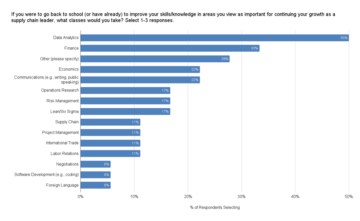
Author’s Note: I was asked by Transporeon (a Talking Logistics sponsor) to look at what is happening in the European transportation market and they provided me with access to their Transporeon Market Insights data for additional insights and perspective. I once again shared my commentary for this month in a brief Transporeon Journal Market Update video commentary. Below are my introductory remarks. I encourage you to watch the full commentary for more details on what is happening in the European transportation market, and to hear from Lena von Fritschen, Director of Market Intelligence at Transporeon, who shares some insights on the expected toll increases in Germany, and Sandro Russo, Carrier Manager at Transporeon, who provides commentary on the shrinking labor force.
Can you believe we’re at the halfway mark of 2023 already? It’s like halftime at a football match and supply chain and logistics professionals are in the locker room preparing for the second half. What adjustments do you need to make to finish the year strong?
Do you need to revisit your transportation strategy and contracts? Adjust your inventory management policies? Find new suppliers? Fire some customers? Reduce the number of SKUs you offer? Revamp your employee hiring, training, and retention programs? Outsource more functions to third parties — or maybe bring some outsourced operations back in-house?
Those are just a few questions worth considering before taking the field again, because I’m sure not everything went according to plan in the first half of the year, and the weeks and months ahead remain as unpredictable and risky as ever.
What’s top of mind for many businesses at the moment is the economy, especially in Europe. It’s been sluggish for more than a year and the outlook remains cloudy at best. As reported by CNBC on June 8th, “The euro zone entered a recession in the first quarter of this year, and economists are not optimistic for the coming months.”
According to the article, “The 20-member bloc reported gross domestic product of -0.1% for the first quarter [of 2023], according to revised estimates from Eurostat…The euro zone also contracted by 0.1% in the last quarter of 2022. Ireland, the Netherlands, Germany and Greece are among the euro economies that reported an economic quarter-on-quarter contraction for the first quarter [of this year].”
To quote from a June 8th article in the Wall Street Journal: “Economists think all this points to a slow and protracted recovery for the continent later this year, where consumers and businesses are also feeling the drag from higher borrowing costs as the European Central Bank continues to raise interest rates to fight inflation.”
So, when it comes to the economy and inflation, the scale remains tilted a bit toward the pessimistic side.
Meanwhile, on the supply chain front, “supply chain pressures continue to plague mid-sized businesses [in the UK] with 77% facing persistent disruptions in their supply chains,” according to a survey of 500 medium-sized businesses conducted by the accountancy and business advisory firm BDO.
The June 5th press release adds that “Faced with these prolonged pressures, almost half (49.8%) of mid-sized businesses say they will be focusing on onshoring as much of their operations as possible in the next 12 months.”
This onshoring trend isn’t just limited to the UK. “Demand for Europe factory space rises 29% amid ‘nearshoring’ rush,” was the headline in a June 13th Financial Times article.
No doubt, the use of robots in both manufacturing and warehousing — as well as growing geopolitical risks — is getting companies to think beyond “cheap labor” when developing their manufacturing and sourcing strategies moving forward.
That said, onshoring is easier said than done. One of the big challenges is getting your suppliers and other trading partners to make the move too. In the BDO survey, for example, 20% of the responders said that “there are no UK-based suppliers capable of delivering the services they need.”
Nonetheless, this is a trend worth keeping an eye on because depending on how widespread onshoring becomes, it can have a significant ripple effect impact on transportation and distribution networks in the months and years ahead.
Speaking of transportation, where are we today compared to a year ago? Watch the short clip below for some Market Insights data and commentary. Then continue watching the rest of the video for additional insights, data, and advice related to the European transportation market, including Lena’s and Sandro’s commentaries on what’s happening with tolls and the labor market.
[embedded content]
- SEO Powered Content & PR Distribution. Get Amplified Today.
- PlatoData.Network Vertical Generative Ai. Empower Yourself. Access Here.
- PlatoAiStream. Web3 Intelligence. Knowledge Amplified. Access Here.
- PlatoESG. Automotive / EVs, Carbon, CleanTech, Energy, Environment, Solar, Waste Management. Access Here.
- PlatoHealth. Biotech and Clinical Trials Intelligence. Access Here.
- ChartPrime. Elevate your Trading Game with ChartPrime. Access Here.
- BlockOffsets. Modernizing Environmental Offset Ownership. Access Here.
- Source: https://talkinglogistics.com/2023/07/10/across-the-pond-the-european-transportation-market-july-2023/
- :is
- :not
- :where
- 12
- 12 months
- 2022
- 2023
- 49
- 500
- 5th
- 8th
- a
- access
- According
- across
- Additional
- Adds
- adjustments
- advice
- advisory
- again
- ago
- ahead
- All
- already
- also
- Amid
- among
- an
- and
- ARE
- article
- AS
- asked
- At
- back
- Bank
- BDO
- BE
- because
- becomes
- been
- before
- believe
- below
- BEST
- Beyond
- Big
- Bit
- Borrowing
- both
- bring
- business
- businesses
- by
- CAN
- capable
- central
- Central Bank
- chain
- chains
- challenges
- CNBC
- CO
- comes
- coming
- Commentary
- Companies
- compared
- conducted
- considering
- Consumers
- content
- continent
- continue
- continues
- contraction
- contracts
- Costs
- Customers
- data
- delivering
- Depending
- details
- developing
- Director
- disruptions
- distribution
- do
- Domestic
- done
- doubt
- easier
- Economic
- economies
- economists
- economy
- effect
- embedded
- Employee
- encourage
- entered
- especially
- estimates
- Euro
- Euro Zone
- Europe
- European
- European Central Bank
- EVER
- everything
- example
- expected
- eye
- facing
- factory
- few
- field
- fight
- Find
- finish
- Fire
- Firm
- First
- focusing
- Football
- For
- Force
- Forward
- from
- front
- FT
- full
- functions
- geopolitical
- Germany
- getting
- Greece
- gross
- Growing
- Half
- halfway
- Happening
- Have
- headline
- hear
- higher
- Hiring
- How
- HTML
- HTTPS
- i
- Impact
- in
- Including
- Increases
- inflation
- insights
- Intelligence
- interest
- Interest Rates
- introductory
- inventory
- Inventory Management
- ireland
- IT
- journal
- jpg
- July
- june
- just
- keeping
- labor
- labor market
- Last
- later
- like
- Limited
- Locker
- Locker Room
- logistics
- Look
- make
- management
- manager
- manufacturing
- many
- mark
- Market
- market insights
- Market Update
- Match
- maybe
- me
- mind
- moment
- Month
- months
- more
- move
- moving
- much
- my
- Need
- Netherlands
- networks
- New
- next
- no
- note
- number
- of
- offer
- on
- once
- ONE
- Operations
- Optimistic
- or
- Other
- Outlook
- outsource
- parties
- partners
- perspective
- pessimistic
- Plague
- plan
- plato
- Plato Data Intelligence
- PlatoData
- player
- points
- policies
- POND
- possible
- preparing
- pressures
- Product
- professionals
- Programs
- provided
- provides
- Quarter
- Questions
- quote
- raise
- Rates
- recession
- recovery
- reduce
- related
- remain
- remains
- Reported
- REST
- retention
- Ripple
- Rises
- risks
- Risky
- robots
- Room
- rush
- Said
- say
- Scale
- Second
- Services
- shared
- Shares
- Short
- side
- significant
- slow
- sluggish
- some
- Sourcing
- Space
- sponsor
- strategies
- Strategy
- street
- strong
- suppliers
- supply
- supply chain
- Supply chains
- sure
- Survey
- taking
- talking
- than
- that
- The
- the Netherlands
- the UK
- The Wall Street Journal
- their
- then
- These
- they
- Think
- Third
- third parties
- this
- this year
- times
- to
- today
- too
- top
- toward
- Trading
- Training
- transportation
- Trend
- Uk
- unpredictable
- Update
- use
- Video
- von
- Wall
- Wall Street
- Wall Street Journal
- Warehousing
- was
- Watch
- we
- Weeks
- WELL
- went
- What
- What is
- when
- WHO
- widespread
- will
- with
- worth
- WSJ
- year
- years
- you
- Your
- youtube
- zephyrnet





![[Video] Riviana Foods: Using Optimized Load Building to Reduce Transportation Costs and Improve Sustainability](https://platoaistream.net/wp-content/uploads/2023/08/video-riviana-foods-using-optimized-load-building-to-reduce-transportation-costs-and-improve-sustainability.jpg)






![[Video] Going Beyond The TMS Status Quo](https://platoaistream.net/wp-content/uploads/2023/02/video-going-beyond-the-tms-status-quo.jpg)